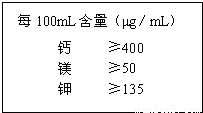题目内容
“××”牌天然水的部分特征性指标如表所示,表中的“钙、镁、钾”是指( )
A.分子
B.原子
C.元素
D.非金属
【答案】分析:欲正确解答本题,须知分子、原子、元素和非金属的概念与区别,还要了解表中的“钙、镁、钾”是以什么形式存在.
解答:解:钙、镁、钾都是以化合物的形式存在于水中,化合物是由元素组成的,故表中的“钙、镁、钾”是指元素.故选C.
点评:本题主要考查学生对分子、原子、元素和非金属的概念的理解,以及分辨物质存在形式的能力.
解答:解:钙、镁、钾都是以化合物的形式存在于水中,化合物是由元素组成的,故表中的“钙、镁、钾”是指元素.故选C.
点评:本题主要考查学生对分子、原子、元素和非金属的概念的理解,以及分辨物质存在形式的能力.

练习册系列答案
相关题目
In 1997, I found myself in a situation I never thought I'd be in: alone and begging for money in New York. My father had been separated from our family, and my mother had recently died from complications related to AIDS. What I remember most about such nights is lying on the cold marble floor and using my backpack for a pillow.
Even though I had lost my family, I made choices every single day to turn my life around. There was the haven for homeless teenagers called the Door, a non-profit organization that provided me with guidance, medical care and food, all of which kept me going while I completed my homework in train stations and under hallway lights. Perhaps the most surprising help though, I did not seek out﹔it found me. The New York Times told my story. In the weeks that followed, dozens of strangers reached out to me from all across the United States. At my high school, I began receiving handwritten letters of encouragement. Strangers showed up bearing clothes, books, and even hugs. Since the article mentioned I was applying to Harvard, one woman knitted a blanket for me. She attached this note to the box it was posted in: "It gets cold in those dorms. May you warm yourself knowing that people care about you".
With the help of these people, my life today bears no resemblance at all to my life then. I graduated not only from high school but also from Harvard University.
Before these people — some of them nameless— I just didn't realize how good people could be. But now I do, and I can say that the people who helped me have forever changed me. They are the reason behind my decision to join the board at the Door so that I can be part of a small team of people opening a high school for homeless teenagers .They are the reason I dedicate my life to opening pathways for others. And they are the reason I travel around the world helping people transform their own lives.
【小题1】According to the passage, the author______________.
| A.tried to change her life |
| B.often slept m friends’ homes |
| C.felt lonely because of her illness |
| D.felt quite desperate for her father |
| A.It helps the homeless teenagers. |
| B.It is an organization seeking profits. |
| C.It provides entertainment for children. |
| D.It reports the stories about the homeless. |
| A.how the author applies to Harvard |
| B.how the author struggles for her ideal |
| C.how The New York Times helps the author |
| D.how people help the author in different ways |
a. The newspaper reported her story.
b. She graduated from Harvard University.
c. She slept on the cold floor at night.
d. She joined the committee at the Door.
e. Her mother died from the illness.
| A.d→e→c→a→b | B.e→c→d→a→b |
| C.e→c→a→b→d | D.b→c→d→e→a |
| A.Patience is a virtue. |
| B.Love can be passed on. |
| C.Time waits for no man. |
| D.Honesty leads to success. |
已知t℃时四种化合物在水中及液氮中的溶解度如下表:
写出t℃时上述几种化合物在水溶液中及液氮中能发生复分解反应的化学方程式:
在水中: ;
在液氨中: .
| AgNO3 | Ba(NO3)2 | AgCl | BaCl2 | |
| 水 | 170g | 9.2g | 1.5×10-4g | 33.3g |
| 液氨 | 8.6g | 97.2g | 0.8g |
在水中: ;
在液氨中: .
已知t~C时4种化合物在水中和液氨中的溶解度如下:
写出t℃时上述儿种化合物在水溶液和液氨中能发生复分解反应的化学方程式.
在水中: ;
在液氨中: .
| AgNO3 | Ba(NO3)2 | AgCl | BaCl2 | |
| 水中溶解度/g | 170 | 9.2 | 1.5×10一4 | 33.3 |
| 液氨中溶解度/g | 86 | 97.2 | 0.8 | ~0 |
在水中: ;
在液氨中: .
看下面表格,请回答问题:
(表一)地壳里各种元素的含量
(表二)我国渤海、黄、东、南海水中所含主要元素的总量
(1)“表一”与“表二”中对元素含量的表示方法(填相同或不同),“表一”中元素的含量用表示的.
(2)“表一”中含量最高的金属元素和含量最高的非金属元素形成化合物的化学式为.
(3)“表一”中氢元素含量没有单独列出,说明含量较少,而“表二”中氢元素的含量却位居第二,其原因是.
(表一)地壳里各种元素的含量
| 元素名称 | 质量分数 | 元素名称 | 质量分数 |
| 氧 | 48.60% | 钠 | 2.74% |
| 硅 | 26.3% | 钾 | 2.47% |
| 铝 | 7.73% | 其它 | 3.59% |
| 铁 | 3.45% |
| 元素名称 | 元素总量/t | 元素名称 | 元素总量/t | 元素名称 | 元素总量/t |
| 氧 | 3.35×1015 | 钾 | 0.1×1013 | 铜 | 1.1×107 |
| 氢 | 0.4×1015 | 溴 | 2.5×1011 | 镍 | 0.8×107 |
| 氯 | 7.2×1013 | 氟 | 0.5×1010 | 铝 | 0.8×107 |
| 钠 | 4.0×1013 | 磷 | 2.7×108 | 锰 | 0.8×107 |
| 镁 | 0.5×1013 | 碘 | 2.3×108 | 钛 | 0.4×107 |
| 硫 | 0.3×1013 | 铁 | 0.4×108 | 银 | 1.4×105 |
| 钙 | 0.2×1013 | 锡 | 1.1×107 | 金 | 1.5×104 |
(2)“表一”中含量最高的金属元素和含量最高的非金属元素形成化合物的化学式为.
(3)“表一”中氢元素含量没有单独列出,说明含量较少,而“表二”中氢元素的含量却位居第二,其原因是.